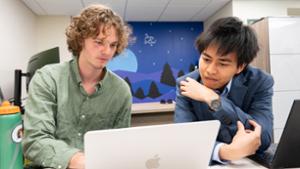
“It’s an incredible opportunity for our students to present their research to — and get feedback and input from and build connections with — some of the leading environmental scientists from all over the world,” Strong said. “This is how science works; it’s done in a community, and presenting at AGU is a great way for Hamilton students to join that global community of environmental scientists.”
Benson, one of Kropp’s senior thesis students, presented research in which she analyzed the effects of weather and precipitation patterns on sap-flux-scaled transpiration rates in tree species and how the soil microclimate has different reactions in various land class covers.
Talking about her research with fellow scientists at AGU enabled Benson to make connections. “I even got to talk about my sap flow project with someone who was involved in the creation of the technology I used,” she said. After Hamilton, Benson hopes to eventually pursue a master’s degree or Ph.D. after working in the field.

Tanner’s research grew out of a summer research fellowship she did with Strong in 2021. “With Professor Strong, I modeled one meter of sea level rise on Long Island, N.Y., and analyzed its effects on carbon sequestration in salt marshes,” she said. “I was working remotely from home, so it was particularly special to present my work in person at the AGU meeting and discuss it face-to-face with professionals.” Strong and Tanner are developing the research for a publication.
“This is how science works; it’s done in a community, and presenting at AGU is a great way for Hamilton students to join that global community of environmental scientists.”
Tanner said attending the conference “both affirmed the value of my research and introduced me to the wide variety of subjects in environmental science. I’ve definitely come away with a broader understanding of the kinds of research I might want to do in the future, as well as connections to some of the people and institutions doing that work.” She said a highlight was “meeting a Hamilton alum [Rick Murray ’85] who works at Woods Hole and getting to talk all things Hamilton and biogeochemistry with him.”
After Hamilton, Tanner hopes to broaden the modeling-based skills she’s learned and do field-based research in either wetland or marine conservation.

Sangree’s research topic was on how a floating treatment system can remove nitrogen pollution from small ponds by taking advantage of microbial activity.
AGU has about 20,000-25,000 participants and is the premier environmental science conference globally. “Most presenters are professors, post-docs, or graduate students, and there are only a handful of undergraduate presenters,” Strong added.
Kropp also gave an oral presentation on her research, “Quantifying Long-Term Changes in Urban Land Cover Using Historical and Present-Day Aerial Imagery, with Implications for the Urban Microclimate.”
A School of Opportunity
A Hamilton education is accessible to the most talented students from around the world, regardless of their family’s financial background.
Posted January 11, 2023


